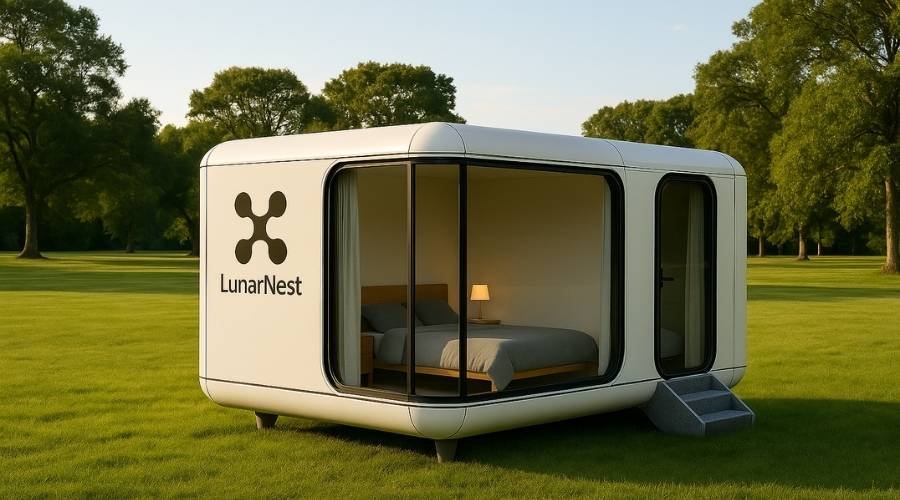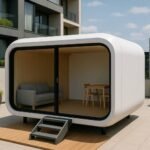Understanding Eco-Friendly Homes
We’re all about finding better living spaces that make Mother Earth smile. Enter eco-friendly modular homes, the rockstars of sustainable living! These snazzy residences don’t just sit pretty – they champion green living like pros.
Advantages of Modular Homes
Modular homes, or as some folks call ’em, prefab homes, are stealing the show with their smart use of eco-tech and snappy design. Why are they garnering such raves?
- Waste Reduction: Built in a factory, these homes cut down on construction waste big time. Thanks to precise material use, they’re way less wasteful than your usual on-site builds.
- Energy Efficiency: Picture this – homes that keep your energy bills in check! With energy-smart designs, they use less power both when being built and when you’re living in ’em.
- Water Efficiency: Say goodbye to water waste. Many modular houses come fitted with nifty water-saving tech, making sure that every last drop counts.
- Healthy Living Environments: No funky chemicals here! With a focus on sustainability, these homes create cleaner, greener spots to live.
- Quick Builds: Factory-built homes are like the fast food of construction (in a good way). Quicker to build, and no waiting around for the rain to stop.
- Earth-Loving Materials: Using stuff from renewable resources, they champion sustainability and show some love to the planet.

Check out the emissions showdown:
| Construction Type | Carbon Emissions Reduction |
|---|---|
| Old School Construction | 0% |
| Cool Modular Homes | 45% |
That big drop is thanks to the factory setups, cutting down on loads of trips and transport chaos. Choosing modular homes means we’re fighting waste, saving resources, and making a smaller carbon footprint than ever. Want to explore more? Check out affordable modular homes, modern modular homes, and modular homes in Australia for more on this hot trend in sustainable living.
Sustainable Materials in Construction
When it comes to building our eco-friendly pads, materials are the name of the game. The right picks can seriously lower our footprint. Here’s the lowdown on some green champs:
- Recycled Materials: Old steel and reclaimed wood get a second life, meaning less demand for brand-spankin new resources while tackling waste too.
- Bamboo: Fast-growing and oh-so-renewable, bamboo is a top pick for several uses in our prefab homes.
- Cross-Laminated Timber: This heavy-duty wood isn’t just durable; it locks carbon away and helps shrink the carbon footprint of our digs.
Turning the focus on eco-friendly materials means we’re tossing our hat in the ring for better, planet-friendly living. Curious about the backbone of the modular home scene? Dive into prefabricated homes in Australia and soak up the innovations and eco-smarts driving this industry.
Eco-Friendly Features
We’re all about combining comfort, privacy, and affordability, and, in doing so, we’ve realised that eco-friendly modular homes have a ton of perks. Two big hits on the list are saving energy and saving water.
Energy-Efficient Design
When you think of saving energy, these modular homes get an A+ for their clever design. They’re built with good-for-the-environment stuff like recycled steel and sustainable wood, which means they last longer without using up loads of resources.
A lot of these homes come with gadgets that won’t blow up your electric bill, top-notch insulation, and nifty solar panels. They’re a smart pick if you’re looking to save money in the long run. Plus, their compact design, paired with these smart features, chops down electricity use big time.
Check out what they offer:
| Feature | Description |
|---|---|
| Snug Sealing | Stops energy from slipping away and saves on heating and cooling. |
| Smart Insulation | R-49-21 insulation keeps the temp just right and slashes energy needs. |
| Smarter Windows | Helps hold warmth in winter and keeps it breezy in the summer. |
| Cheaper Energy Bills | All this adds up to savings on your bills. |
Modular homes are made thinking about staying green; they fit together tightly and insulate better than your typical house. Plus, they pack in less waste during construction, making them kinder to our planet. Curious about saving money? Check out ur piece on affordable modular homes.
Water Conservation Solutions
Running an eco-friendly modular home means cutting back on water waste while staying comfy. They’re stuffed with features that help out with water conservation without cramping your style.
What you’ll find:
- Taps and showers that use less water
- Toilets with flushing options to save water
- Landscaping that doesn’t need much water
- Systems to catch rain for future use
- Recycling water for your garden and loo
With these tricks up their sleeve, these homes take a chunk out of water use. Using reclaimed, recycled stuff adds to their green game and benefits health and longevity. Fancy something modern? You might want to check out modern modular homes.
By jumping on these eco-friendly features, we trim down our impact on the planet and whip up homes that are both affordable and sustainable. For more about living this way in AU, swing by our page on modular homes AU and dig into prefabricated homes AU.
Green Technology Integration
Incorporating green tech into our modular homes isn’t just about ticking off a sustainability box. It’s about making our living space more comfy and efficient while doing our bit for the planet. The big players here? Solar panels, renewable energy, and smart home systems.
Solar Panels and Renewable Energy
Think of solar panels as the MVP of eco-friendly homes. They take sunshine and turn it into electricity, powering our homes without the guilt trip about the environment. The setup of these homes makes plopping solar panels on top a breeze, capturing that sweet, sweet solar juice right above us. Long story short, this move slices down our carbon footprint and keeps those electricity bills from terrifying us each month.
| Solar Panel Perks | Why We Love It |
|---|---|
| Light up the house | Saves us money on bills |
| Good for the planet | Cuts down on fossil fuel |
| Boosts home value | Buyers dig energy-efficient homes |
Our modular homes go the extra mile with snazzy appliances and killer insulation, making them super wallet-friendly in the long haul. We end up sipping less juice (electricity, that is), which helps us walk the talk when it comes to sustainability.
Smart Home Systems
Let’s talk about smart home stuff—it’s a game-changer for making our homes efficient and cozy. Imagine controlling everything from your lights to your heater without lifting more than a finger, thanks to your smartphone. Programmable thermostats make sure we’re not wasting juice when we’re out chilling somewhere else.
The Living Screen House in Sydney is a top example here, flaunting its advanced smart systems with sustainable style. It’s got neat tricks like a water-saving system, solar goodness, and LED lights, all contributing to an eco-friendly vibe.
| Smart System Stuff | What’s In It for Us |
|---|---|
| Program those thermostats | Kicks energy waste to the curb |
| Control from afar | Ultimate in chill convenience |
| Keep tabs on energy | Smarter power use |
Merging these modern tech touches into our modular homes feels like a leap toward a greener scene. No matter what modular home variety we’re eyeing—budget-friendly or sleek and modern—the real win is embracing energy-savvy and smart tech for our sweet spots.

Economic Benefits
Initial Cost vs. Long-Term Savings
When we think about eco-friendly modular homes, we often weigh the upfront expenses against the long-term financial perks. Sure, getting started might pinch the wallet a bit harder, but this isn’t a case of penny-wise, pound-foolish. The real savings roll in over time.
These homes come with some slick energy-saving tricks up their sleeve. Good insulation, windows that play nice with the weather, and solar panels that zap costs way down. All of this magic translates to smaller bills every month.
Just to put some numbers behind this, check out how eco-friendly homes fare compared to their traditional cousins:
| Home Type | Average Monthly Energy Cost (USD) | Potential Savings Over 10 Years (USD) |
|---|---|---|
| Traditional Home | 200 | 0 |
| Eco-Friendly Modular Home | 120 | 9,600 |
By picking green, we’re not only hugging trees but also cutting back on those monthly expenses. So, these homes aren’t just eco-conscious—they’re smart for the wallet.
Property Value Appreciation
Eco-friendly modular homes aren’t just good for Mother Earth—they’re also kind to our bank account. Their value tends to puff up over the years for a few reasons:
- Energy-Savings Charisma: Everyone likes to save a few bucks, right? Energy-efficient homes often attract buyers who want to trim their utility bills, boosting resale value.
- Lasting Style: Built from eco materials that stand the test of time with little fuss, these homes catch the eye of folks who want sustainability without the headache.
- Seal of Approval: Homes flaunting badges like LEED or ENERGY STAR make buyers swoon, often commanding top dollar for their green credentials.
- Booming Popularity: With more people jumping on board the green train, the demand for eco-friendly modular homes is rising, pushing their market value up, up, and away.
Here’s a quick look at how these homes rise in value against the usual suspects:
| Home Type | Average Appreciation Over 10 Years (%) |
|---|---|
| Standard Home | 30 |
| Eco-Friendly Modular Home | 45 |
Getting into eco-friendly modular homes means we’re doing right by our planet and our pockets. If you’re curious about other money-saving, comfy living options, have a peek at affordable modular homes and modern modular homes and see the bright future that awaits!
Modular Construction Advantages
When we chat about eco-friendly modular homes, two big perks pop up right away: building speed and rock-solid quality. These are the game changers for families, singles, and even businesses looking to set up cosy, private, and budget-friendly nests.
Time Efficiency in Building
The speed at which a modular home goes up is like magic. Seriously, these homes are done in no time compared to traditional options. With pre-made chunks put together like Lego in a controlled factory, the whole setup isn’t at the mercy of Mother Nature or material hiccups. Some folks move into their new digs in a matter of months – it’s like finding a unicorn when you’re in a rush for a new place!
| Building Speed | Traditional Houses | Modular Homes |
|---|---|---|
| Build Time | 6-12 months | 3-6 months |
| Weather Drama | A Big Deal | Not Much |
| Material Roadblocks | Happens Often | Not So Much |
This speedy setup gets us living the dream way faster. If you’re working on a tight schedule or have a deadline breathing down your neck, modular homes are a neat solution for cheap, quick housing.
Quality Control Measures
Quality is the name of the game in modular construction. Putting these modules together in a factory lets them keep a close eye on every part. They make sure all the stuff used and every detail meets the top notch. Unlike traditional homes with different contractors, which might slip up here and there, modular homes stick to the script with no room for error.
This ensures the house isn’t just well-built but could even reduce how often you need to fix stuff in the long run. Opting for eco-friendly modular homes means we’re betting on sturdy and efficient pads. Want to know more about living sustainably? Peek at our pieces on affordable modular homes and modern modular homes.
Innovations in Sustainable Materials
Peek into the exciting world of eco-friendly modular homes, and you’ll see a bustling hub of creativity aimed at crafting spaces that are good for us and the Earth. Some materials leading the charge include reused steel, trusty old wood, bamboo, and cross-laminated timber (CLT).
Recycled Steel and Wood
Reused steel is a real heavyweight champ in green construction. It’s endlessly recyclable without losing its mojo, which means less strain on Mother Earth and a big pat on the back for supporting sustainable living. Tossing recycled steel into our modular homes means we cut down on the need for brand-new raw stuff, making our resource usage smarter, not harder.
Wood’s an old friend in the building game. It’s a featherweight compared to steel and cement, which makes handling it a breeze. Plus, when we’re done with it, we can give it a new life or recycle it into something fresh. The stuff’s tough, too – wooden buildings can hang around for ages even without today’s snazzy preservation methods. Together, steel and wood play a key role in building homes that care for our part of the planet.
| Stuff | Perks |
|---|---|
| Reused Steel | Green as they come – Reusable again and again – Saves precious new materials |
| Wood | Eco-friendly with a twist – Feather-light – Ready for round two, or three – Tough as old boots |
Bamboo and Cross-Laminated Timber
Bamboo isn’t just for pandas; it’s a dynamic material perfect for modular homes. With speedy growth, it packs a punch with its strength and quick comeback skills, making it top-tier for planet-friendly builds. Using bamboo means we can expand our shelters without overloading forests.
Then there’s cross-laminated timber, or CLT, which is making waves in modular home-building circles. CLT doesn’t just hold up well structurally, it also puts out way less carbon compared to traditional builds with concrete and steel. These qualities make CLT an ace choice for eco-friendly projects.
| Material | Standout Traits |
|---|---|
| Bamboo | Growth superstar – Built-in strength – Bounces back in no time |
| Cross-Laminated Timber | All about efficiency – Solid as a rock – Cuts carbon output down to size |
Taking a closer look at these materials, it’s clear each new idea edges us towards a planet-friendly tomorrow, letting us craft homes that don’t just make sense for our wallets, but for our world, too. Dive further into what modular living can offer by peeking oat ur handy guides on affordable modular homes and modern modular homes.





